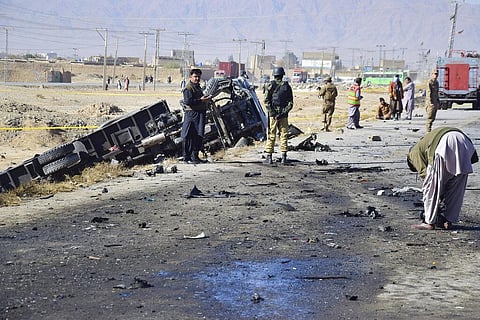

A spurt in terror activities within its borders has led Pakistan to warn Afghanistan of military action. The latter has been accused of harbouring the outlawed Tehreek-e-Taliban Pakistan (TTP). The ‘Afghan Taliban’ strongly denied such reports and claimed that ‘Pakistani Taliban’ (TTP) or its camps do not exist within its boundaries.
Ironically, the outfits that Islamabad and Rawalpindi nurtured in the long war against separate occupiers in Afghanistan have now turned their guns on its hosts.
The TTP, reports suggest, is planning to throw the Pakistan government out of the Khyber Pakhtunkhwa (KP) province. The terror group intends to establish the law of Sharia.
An US State Department report says that “several UN- and U.S.-designated terrorist groups that focus on attacks outside the country continued to operate from Pakistani soil in 2021, including the Haqqani Network, Lashkar-e-Tayyiba (LeT), and Jaish-e-Mohammed (JeM)”.
According to the US Department of State Country Reports on Terrorism 2021 (February 27, 2023), “Terrorist and insurgent groups, including ISIS-K, elements of AQ (including affiliate al-Qa’ida in the Indian Subcontinent [AQIS]), and terrorist groups targeting Pakistan (such as Tehrik-e-Taliban Pakistan), continued to use Afghanistan, especially its remote regions, as a safe haven throughout 2021.”
Northern Pakistan, particularly the Federally Administered Tribal Areas, called Tribal Areas, has always been a haven for refugees from neighbouring Afghanistan. Under the tutelage of Pakistan’s spy agency ISI, able-bodied Afghans in refugee camps later took up guns and joined Islamic extremist groups.
Even today, “ISIS-K, elements of al-Qa’ida (including affiliate AQIS), and terrorist groups targeting Pakistan — such as Tehrik-e Taliban Pakistan (TTP) — continued to use the Afghanistan-Pakistan border region as a safe haven,” the State Department report added.
Pakistan shares a porous border with Afghanistan where the adjoining areas are designated ‘Tribal Agencies’. These are semi-autonomous regions, administered by an appointee of the federal government. This border has been used for the illicit and discreet movement of men and logistics. Pakistani spy agency ISI took this route to launch Mujahidin fighters across the border during Soviet occupation.
The efforts spawned a monster-out-of-control. The Mujahids grew in power along the Afghan border – from Peshawar to Quetta, and beyond. A new breed of fighters called the Taliban or ‘students’ evolved.
The US, through the CIA, channelled billions of dollars into Pakistan in covert assistance against the Soviet forces. Even after their withdrawal, Pakistani military officers continued to assist the fighters. Thus, the route lay open to cross-border transgression. With the withdrawal of Soviet troops, the US had lost interest in Afghanistan. But 9/11 made Uncle Sam march back into Afghanistan.
Today, Islamabad has little, or no control over this region. Local warlords call the shots here, and law enforcing agencies fear to tread. Meanwhile, the fighters grew and fractioned. Power tussles grew, paths got crossed.
The United States does not recognise the Taliban as the Government of Afghanistan. But before pulling its troops out of Afghanistan, it had entered into an agreement with the Taliban leadership based in Doha. It is part of this leadership which is largely governing Kabul now.
Even as a Taliban takeover seemed imminent in Kabul, there were reports that New Delhi too had made overtures at the ‘good Taliban’. Indian officials visited Doha to establish contact with the Taliban, claimed Qatar’s Special Envoy for Counterterrorism and Mediation of Conflict Resolution, Mutlaq bin Majed Al Qahtani. He stated this while addressing a web-based academic conference on June 21, 2021, hinting that India may recognise the rising influence of the Taliban in Afghanistan. However, there has been no official confirmation of this in India.
While making the statement, Qahtani clarified that he was participating in an informal discussion in a personal capacity. “I understand that there has been a quiet visit by Indian officials to speak with the Talibans,” he said then, adding, “Taliban is a key component, or should be, or is going to be a key component – of the future Afghanistan”. He said that in his view it is the reason for dialogue and reaching out to all parties in Afghanistan.
However, the Taliban is a composite rag-tag group of fighters where various leaders are engaged in a battle for supremacy. This was evident in an alleged shootout even as top leaders were discussing the formation of a government in Afghanistan and the members of the proposed cabinet after the Taliban conquered Kabul.
Thus, the Doha Taliban may not have absolute control on the ground. The Pakistani Taliban is yet another umbrella organisation of gun-toting Mujahids, while radical fundamentalist groups like the Islamic State wage its own battle – many of which are even against the Taliban.
Armed bandits leading to hostility in the neighbourhood do not augur well for India. Thus, an effort is on to douse the flames, even if it means reaching out to the ‘good Taliban’ – if that exists.
(Jayanta Bhattacharya is an independendent journalist. These are the writer's views.)